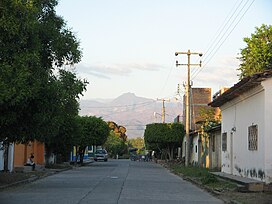The Chimalapas montane forests is a tropical moist broadleaf forest ecoregion in southern Mexico. It includes the montane tropical forests of the Chimalapas region on the boundary of Chiapas and Oaxaca.
| Chimalapas montane forests | |
|---|---|
 | |
 Location of the Chimalapas montane forests ecoregion | |
| Ecology | |
| Realm | Neotropical |
| Biome | tropical and subtropical moist broadleaf forests |
| Borders | |
| Geography | |
| Area | 2,077 km2 (802 sq mi) |
| Country | Mexico |
| States | |
| Conservation | |
| Conservation status | Relatively stable/intact |
| Protected | 278 km2 (13%)[1] |
Geography
editThe Chimalapas region is in the Isthmus of Tehuantepec, and the region's mountains form part of the divide between Mexico's Pacific watersheds to the south and Gulf of Mexico watersheds to the north. The montane forests are bounded by the lowland Petén–Veracruz moist forests on the north. The Chiapas Depression dry forests lie to the northeast. The montane forests adjoin the Sierra Madre de Oaxaca pine–oak forests on the west, and the Central American pine–oak forests to the east. The Southern Pacific dry forests lie to the south between the mountains and the Pacific Ocean.[2]
Climate
editThe climate of the ecoregion is tropical and humid. The forests have a cooler climate than the surrounding lowlands, and average annual temperatures decrease with elevation.[2]
Flora
editThe characteristic plant community is montane tropical evergreen moist forest, also known cloud forest.[3]
Fauna
edit281 species of birds have been recorded in the ecoregion. They include the solitary eagle (Harpyhaliaetus solitarius), great curassow (Crax rubra), highland guan (Penelopina nigra), wood stork (Mycteria americana), keel-billed motmot (Electron carinatum), southern mealy amazon (Amazona farinosa), and chestnut-headed oropendola (Psarocolius wagleri).[3]
Protected areas
editA 2017 assessment found 278 km², or 13%, of the ecoregion is in protected areas.[1] They include El Cordón del Retén Voluntary Conservation Area (153.29 km²).
Chimalapas Conflict
editDuring 2011, the problem in the Chimalapas between Oaxaca and Chiapas over territory boundaries erupted, after more than 45 years in the dispute over the Chimalapas jungles. These have been confrontations between Zoque Chimalapas Oaxacans and Chiapan settlers established on the Oaxaca-Chiapas border.
The Zoque natives who inhabit the Chimalapas of today, to ratify their ownership of those jungles paid the Spanish crown 25 thousand gold pesos, the same ones that Domingo Pintado delivered in a large morro gourd. That is how the legend and history that happened in the remote year of 1685 tells it when that character bought 360 square leagues for the people of Santa María Chimalapa, Oaxaca.
Chimalapas was given that name after the Spanish conquest in the manner of the old foundational genealogies of so many places whose toponymy was established by naming them for the first time.
These testimonies base the ancestral ownership of the two Oaxacan municipalities located in that microregion of the Isthmus of Tehuantepec: Santa María and San Miguel Chimalapas. Both municipalities have had titles to those lands since March 24, 1687, March 15, 1850 and September 17, 1883. The ownership of the Oaxacan Zoque peoples over that territory was ratified to them with a presidential resolution in 1967, based on their original titles. Due to that antiquity both populations demanded and achieved municipality status. Furthermore, ILO Convention 169, signed by Mexico, recognized the colonial documents as valid.
See also
editExternal links
edit- "Chimalapas montane forests". Terrestrial Ecoregions. World Wildlife Fund.
References
edit- ^ a b Dinerstein, Eric; Olson, David; et al. (2017). "An Ecoregion-Based Approach to Protecting Half the Terrestrial Realm". BioScience. 67 (6): 534–545, Supplemental material 2 table S1b. doi:10.1093/biosci/bix014. PMC 5451287. PMID 28608869.
- ^ a b "Chimalapas montane forests". Terrestrial Ecoregions. World Wildlife Fund.
- ^ a b BirdLife International (2020) Important Bird Areas factsheet: Chimalapas. Accessed from http://www.birdlife.org on 19 August 2020.